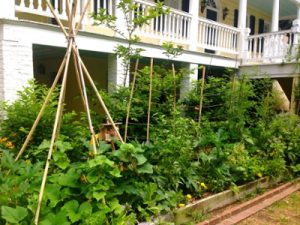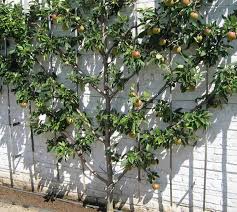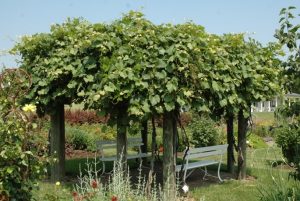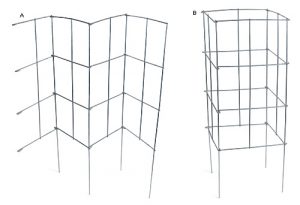Vegetable Supports and Fruit Trellises
By Jan Pickrel, Fairfax Master Gardener Intern

Bamboo trellis
Garden design can easily incorporate both beauty and function. To achieve the goal of both healthy plants and a hefty harvest from tall and vining vegetables, fruits and flowers, the gardener must also plan for supportive structures, such as stakes and trellises.
The first step in the planning process is to know your garden area and what plants you are intending to grow. Placing tall and vining plants on the north side of the garden prevents shading of shorter plants. Also, if planting multiple rows of, or only, tall plants, orienting the staked or trellised rows in a north–south direction will maximize the sunlight that each row can receive, giving all the rows the same sun exposure during the day.

espalier
The next step is to identify specifically which plants you want to grow so that the type of structure, materials needed and size can be chosen. Some vegetables, such as peas and beans, come in both bush and pole (or vining) varieties. Pole beans and runner beans, obvious by their names, need a vertical support or trellis structure to guide their vines, which grow 15 feet long, up and off the ground. Indeterminate tomato vines continue to grow until final harvest, whereas determinate tomatoes (most heritage varieties) tend to be more compact and produce a single fruiting. For larger vegetables or fruit, more sturdy and supportive materials may be needed. Probably the most well-known vegetable supports are cone-shaped tomato cages made of steel: narrower at the bottom, for the base of the tomato plant, and widening at the top for the branching canopy of the indeterminate tomato vine. As vines increase in height and fruit increase in weight, consider tying plant stems and branches at approximately 10-inch intervals so that plants may stay attached during windy summer storms. Heavier fruits, including melons and spaghetti squash, may need slings of quick drying material to support the fruit itself on the vine until it is large enough for harvest. Where the plant is expected to grow many seasons, such as grapes, apples and pears, the gardener might consider formal geometrically-shaped trellises or espaliers. To achieve the effect desired, pruning and additional tying of branches may be necessary. Allow space for reaching in to pick fruit and to bring it through openings. Vining roses along an arbor gate are considered romantic, and trellised grapes in Napa Valley and Italy are considered classic.

grapes on overhead arbor
Both you, the gardener, and the plants benefit from proper staking and securing vines along stakes, poles and trellises. By training the plant upward and outward, instead of mounding it in a tangled pile on the ground, more plants may be grown by using vertical space. This allows easier access for plant inspection, weeding and pest management, and harvest without back bending and squatting on your knees. Fruit is less susceptible to rot and insects, because it is kept off the ground and prevented from sitting in water. Increased air circulation between plants prevents disease and fungus growth while also providing a windbreak and shade to a plant that may otherwise suffer from tissue damage or sunscald. Apple and pear trees were even trained along espaliers to act as fences between different gardens at George Washington’s Mount Vernon, and peach trees were attached to brick walls to save space.
The cost of various stakes, poles, cages and trellises can vary as widely as the gardeners’ preference and imagination. Bamboo stakes or old branches may be tied secured into tripods with old vines at the cost of only the time and energy to find the materials. Strings may be laced between poles to create a trellis upon which to weave pea and bean stalks. Old pantyhose or plastic net turkey bags might be saved and recycled for use as vine ties and fruit supports.

folding tomato cage
In the middle range, one might select galvanized steel tomato cages or powder-coated steel for rust resistance, or folding V-shaped panels (for off-season, flat storage) with stained glass decorative features. Rose and grape arbors might be custom-made and need painting each spring. Whatever your choice, please remember that if you are reusing staking, cages and trellis materials from last season, please inspect and sanitize them with a light bleach solution before taking them into the garden. Similarly, please also inspect and clean your tools!
References
• Espalier Fruit Trees, University of Vermont Extension
• Ten Facts About the Gardens at Mount Vernon, Mount Vernon Ladies Association
• Integrated Pest Management Ideas for Vegetable Gardens, Virginia Cooperative Extension
Publication 426-708
• Planning the Vegetable Garden, Virginia Cooperative Extension Publication 426-312
• Tomatoes, Virginia Cooperative Extension Publication 426-418
• Beans, Virginia Cooperative Extension Publication 426-402
• Cucumbers, Melons and Squash, Virginia Cooperative Extension Publication 426-406
• Arbor, Trellis, or Pergola — What’s in Your Garden?, A Mini-Dictionary of Garden Structures and Plant
Forms, University of Florida Extension Publication #ENH1171



